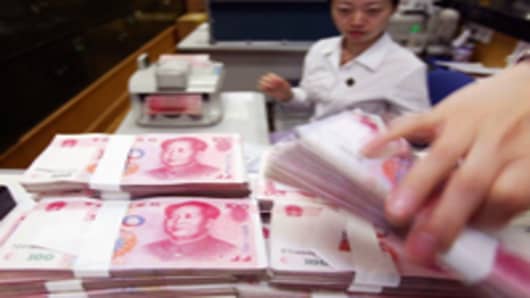China’s unexpected cut in interest rates – the second in less than a month – suggests that the world’s second-biggest economy is in worse shape than it appears and the government is getting worried about growth prospects ahead of the release of key economic data next week.
By surprising markets and slashing the one-year lending rate by 31 basis points to 6 percent and the deposit rates by 25 basis points to 3 percent, Beijing is signaling that it is getting serious about bolstering the economy by lowering borrowing costs for businesses and lifting private-sector investment, economists tell CNBC.
“The timing is earlier than expected, even if we already penciled-in one more cut in the third quarter. This may foreshadow worse than expected growth numbers that are due to release next week,” HSBC economists Qu Hongbin and Sun Junwei wrote in a report on Thursday.
China is due to release closely-watched indicators, including inflation and trade figures for June and second-quarter GDP growth, which economists say may show that the Chinese economy is slowing faster than the government would like. Beijing is targeting a growth rate of 7.5 percent for the economy for 2012.
“The indication is that the data coming out next week will probably be on the weak side,” Zhiwei Zhang, Chief China Economist of Nomura told CNBC Asia’s “Squawk Box”.“This is a much stronger signal than a triple-r cut and this indicates urgency on the very senior level of the government certainly becoming stronger, and that the government is becoming less tolerant of a growth slowdown.”
The Chinese economy may expand 7.6 percent in the second quarter from a year earlier, its sixth straight quarter of slowing growth and its weakest performance since the 2008-09 financial crisis, according to a poll by Reuters Thursday, ahead of the rate move.
If the economy continued to weaken and there is indication that the Chinese government could miss its official target, there will certainly be more stimulus measures, Zhang said. He expects the People’s Bank of China to make at least one more cut of 50 basis points to the reserve requirement ratio (RRR), currently at 20 percent, in July.
China has lowered the amount of cash banks must keep in reserve in three 50-basis point steps since November, freeing up an estimated 1.2 trillion yuan ($190 billion) for fresh lending. The last cut was in May.
Similarly, economists at Barclays said some policy makers “may have underestimated the weakness of sentiment and economic activities” in the first half of the year and that there will be two more RRR reductions in the second half, one in July and another in October.
While boosting domestic lending is a “positive move”, the move on its own may not be enough to boost sluggish growth in China as foreign demand for Chinese goods remains “weak”, said Charles Dallara, Managing Director of Institute of International Finance.
“If you step back and think about it, just a little over two years ago, in 2009, it was not surprising at all to see Chinese exports growing at a 30-plus percent clip,” Dallara told CNBC. “Now you see the value of their exports averaging, in the first part of the year so far, below 10 percent. Clearly, the global environment is weakening and I am afraid we are getting negative synergies among the major economic zones of the world right now.”
Governments all over the world need to do more to prop up the global economy, Dallara said, such as solving the sovereign crisis in Europe, the “fiscal cliff”in the U.S.
- By CNBC's Jean Chua.


